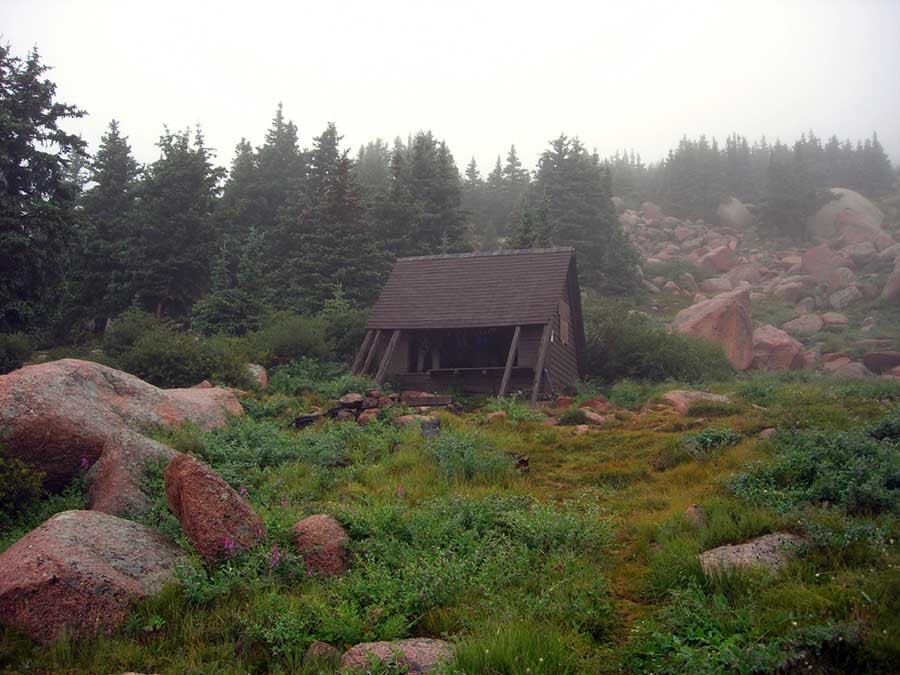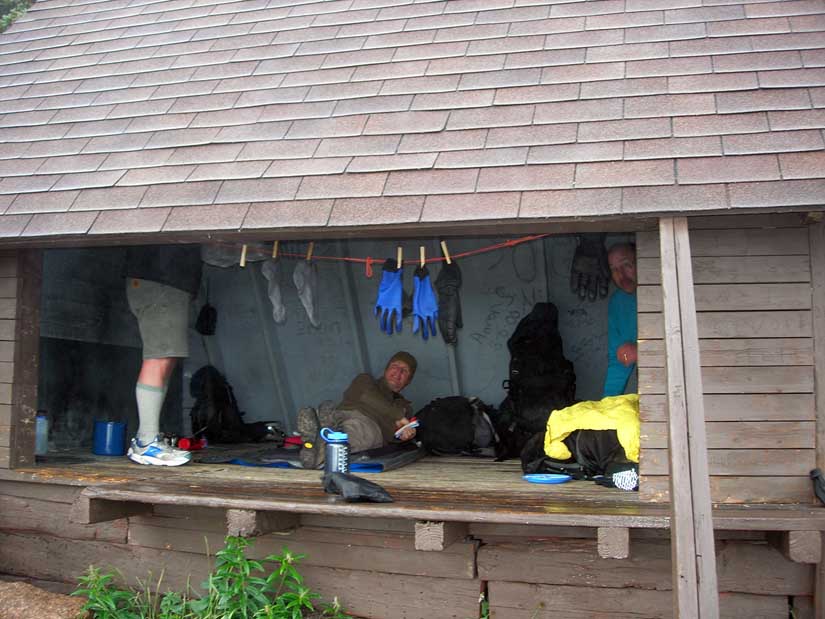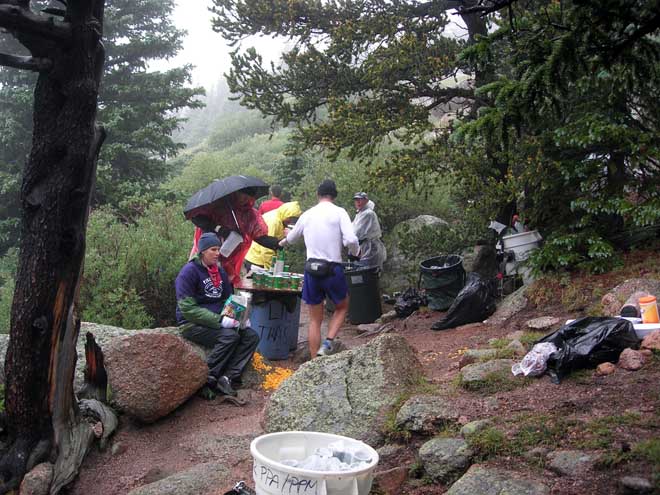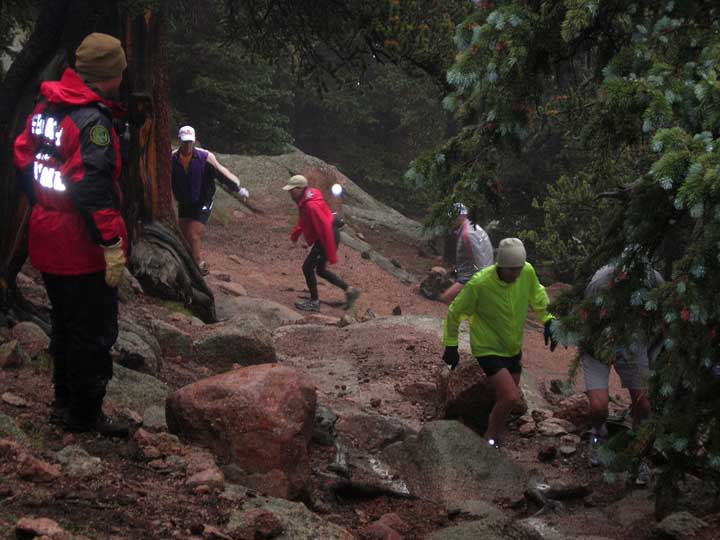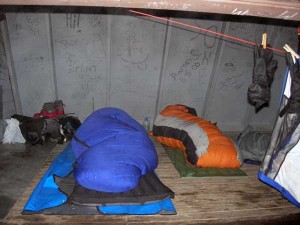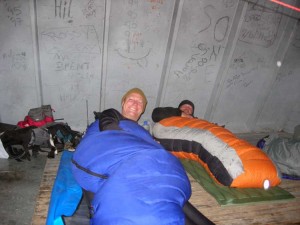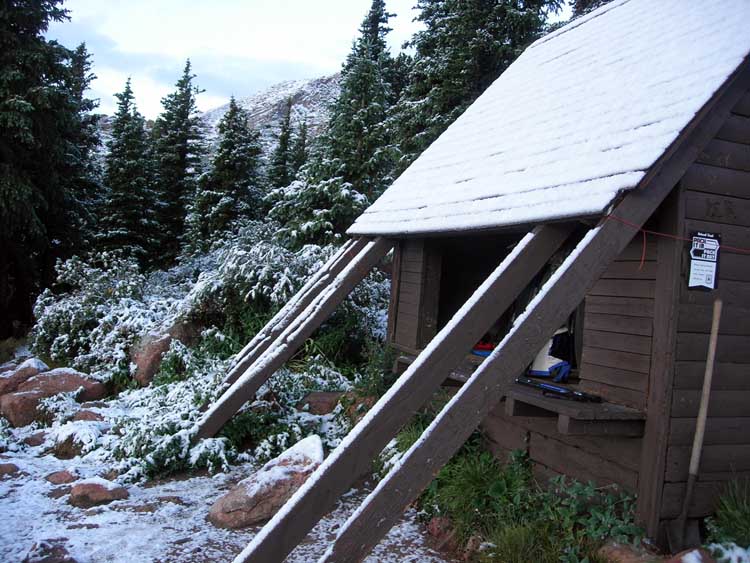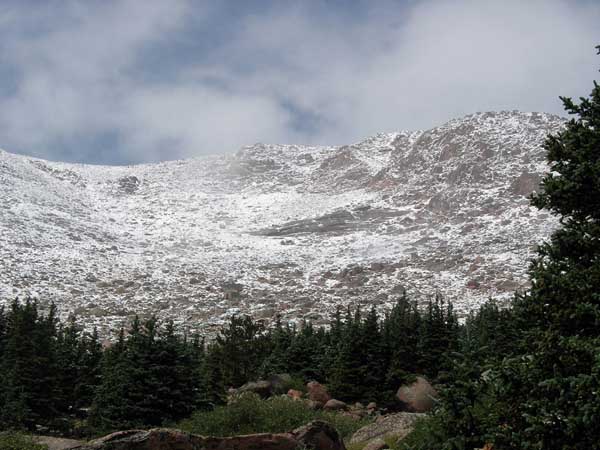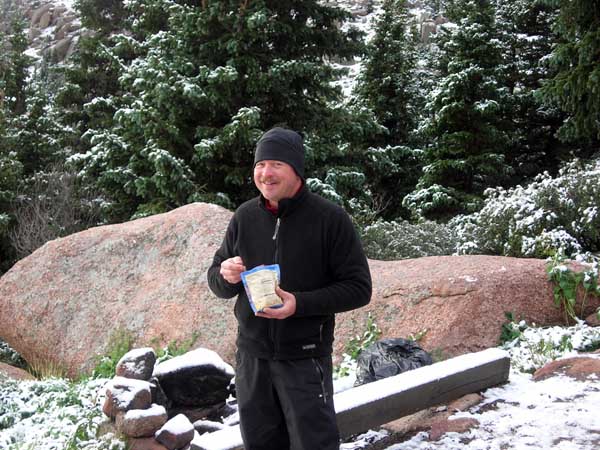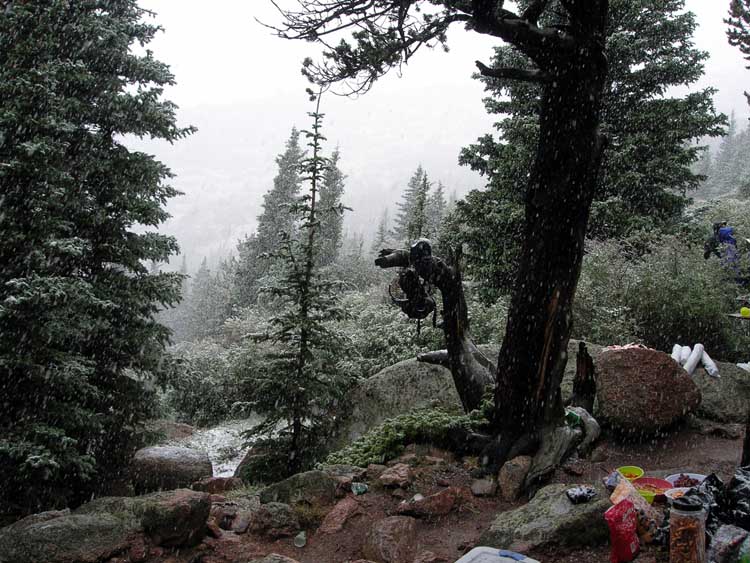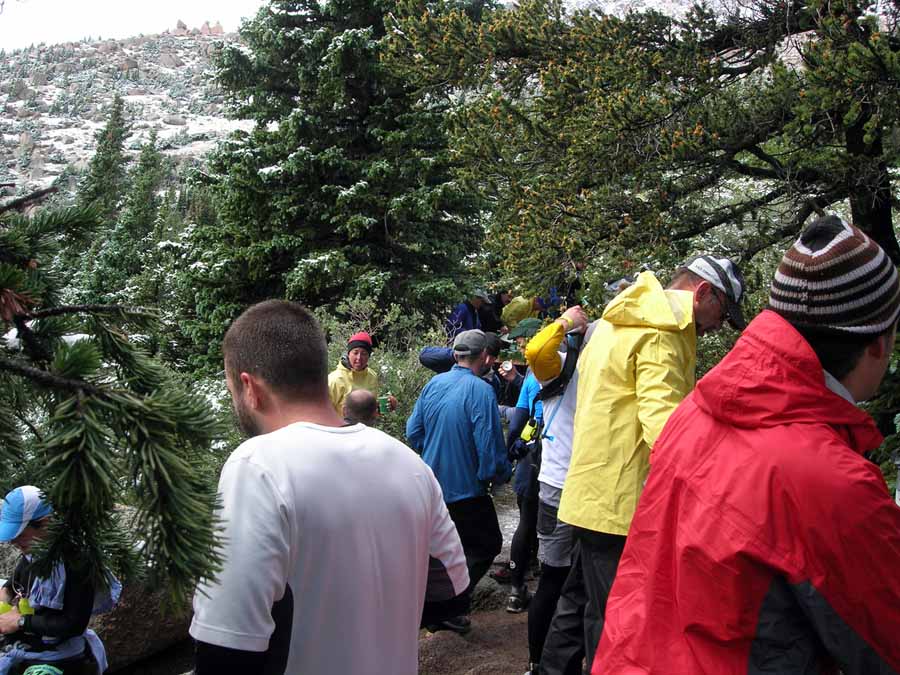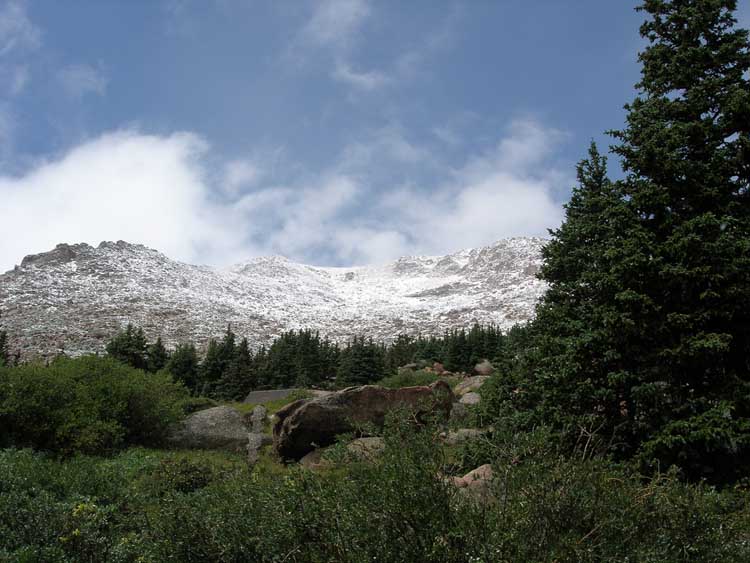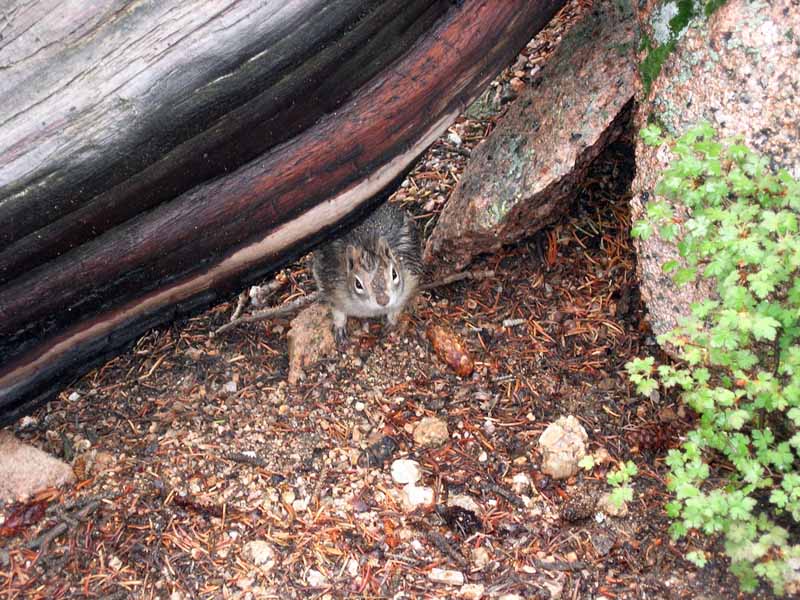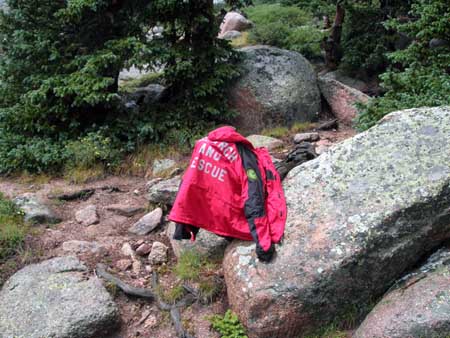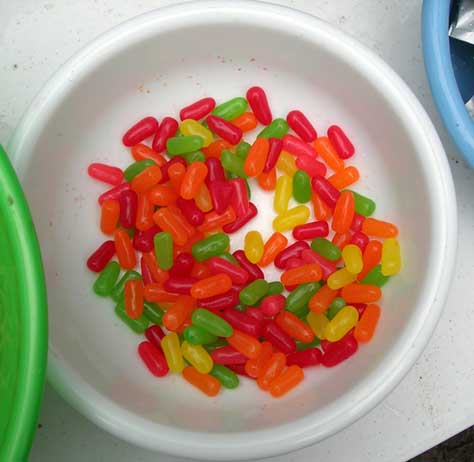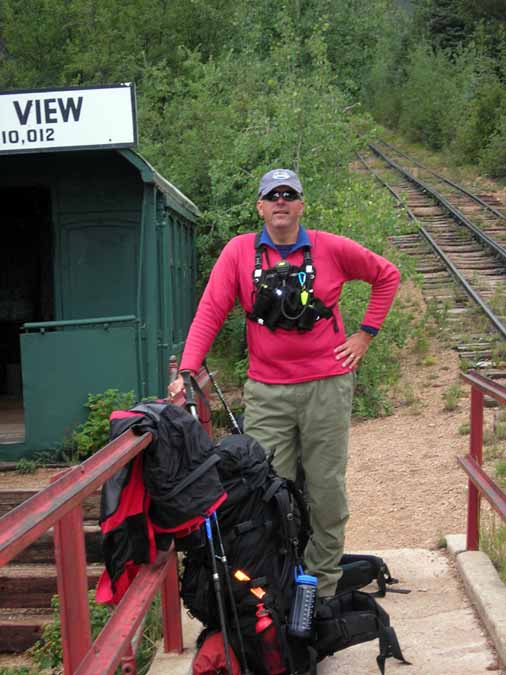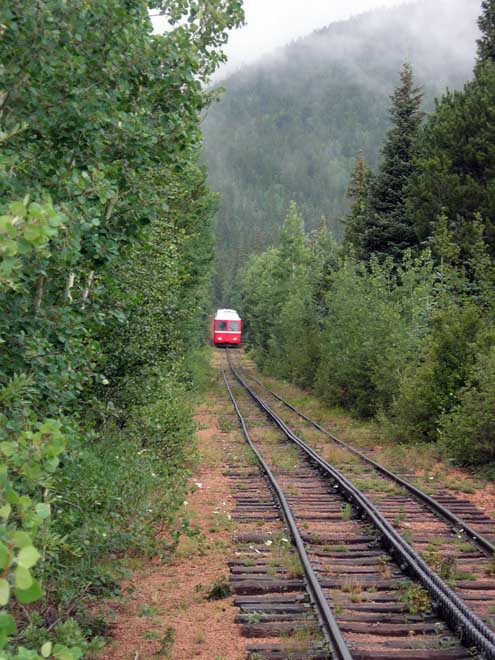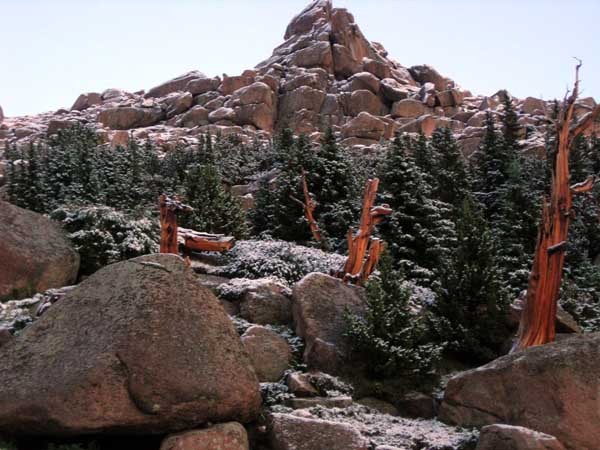“It will be a good test of our equipment…”
A now infamous pre trip quote…
Don and I are sitting in the Pikes Peak Cog Railroad car with our heavy packs between our legs counting the clicks from the cog track as we descend off Pikes Peak down to Manitou and our cars. We think back over the last three days on the mountain…we think about the memories we had acquired and we think about what it will feel like to be back home.
Memories of painful adventures fade quicker than memories of pleasant and great adventures… that is the good news.
By the time I check on my gear on my first day back, most of my gear will be dry. When I touch it to pack it back up for the next adventure, the familiar wetness, cold, and smell I lived with for three days will be gone. It is a race to record these memories for my old age before that gear dries…
This adventure started out innocently enough in May 08 with Don suggesting I work the Pikes Peak Ascent and Marathon as communications support for the Pikes Peak Amateur Radio Emergency service with him.
Don had worked it last year manning a position at Barr Camp at about 10,000’ and he said he had a great time. Near the end of our trip this weekend Don informed me that at Barr Camp, all workers slept inside the cabin on cots/bunks and got a free hot breakfast and dinner each day from the great Barr Camp staff…one can easily see what formed the basis for his fond memories from 2007.
Back in May of this year, Don had suggested we man a more remote outpost and camp out the whole weekend at A Frame at 11,950’ at tree line on the east face of Pikes Peak . We both envisioned a couple of days and nights at tree line with beautiful morning sunrises over Colorado Springs, clear star gazing nights, and perhaps an evening ascent of Pikes Peak and a moonlight descent back to our camp one night. The allure of camping that high on Pikes Peak for two nights was enough for me to place it on the calendar and say yes!
As June and July passed, Colorado experienced its normal weather pattern, a dry start to the summer followed by monsoon season at the beginning of August.
As the date for our weekend event (August 16-17) approached it had been hot and sunny, but as we watched the NOAA website we noticed that on Friday, August 15th, a MASSIVE low pressure system was forecasted to hit Colorado with the biggest cold front since early Spring. Temperatures were expected to plunge from the high 80’s to the 50’s in town with heavy rain for 3-4 days. At altitude where we were going to be staying, forecasts called for 3-6” of snow and lows in the 20’s and highs in the 30’s.
In my line of work this is called a CLUE! While we all agree weather can make any adventure more exciting, I had decided in 2005 that I would no longer plan to go out in epic weather, thinking I was maturing out of that stage where I would “plan” to go out in “known” bad weather. It had gotten me into “trouble” in the past.
So I grew increasingly unsettled the week leading up to our Friday departure, considering different access options to our “station”, whether we should hike in and out each day, and had numerous “what if” discussion with Don. In the end, I decided to suck it up and press forward with the plan.
The “plan” was to catch the last train to the summit on Friday afternoon, hike down from the summit to A Frame and then man the A frame station on Saturday for the ascent and Sunday for the marathon. After the last runners were through on Sunday, we would hike down to Barr Camp and then out the little known access trail to Mountain View Cog railroad station at 10,300’ for a ride down to our cars, saving about 5 miles of slogging down the switchbacks on Barr Trail.
Friday, August 15th, 2008
As Friday dawned you could tell a weather change was in the air as I drove to work. Gathering dark clouds and coolness in the air was apparent. Early stages of drizzle began and any view of Pikes Peak ’s summit vanished. Don and I talked and decided if conditions were too bad when we got to the summit, we would stay on the train back down and descend to the Mountain View station, hike over to Barr Camp then up the three miles to A Frame.
We met at the Cog Railway Station, made last minute changes to my pack’s contents (took out the bivy sack, stuffed in the tent (mistake)), and hopped on the train to the summit with the tourists. As we ascended on the train listening to the conductor give the tourists the high points of the sights and vistas it was obvious there would not be much to see as we reached tree line and entered the clouds. Visibility was 100 feet and the temperature dropped. We were happy these were “comp” tickets (free) for the race workers as there was nothing to see. We had earlier dropped off about 10 aid workers at the Mountain View station who were manning the station at Barr Camp.
Upon reaching the summit, Don and I decided on our final gear to put on (full winter alpine) and made our final adjustments to our packs as we waited for tourists to dart out of the train, snap a quick picture in front of the Pikes Peak sign and then run for the summit house for a cola and a warm doughnut. I am not making fun of the tourist as they had good reason to run…it was windy, cold, and a full drenching of snow, sleet and grapple was raining down on them dressed in shorts and t shirts.
Actually going in for a doughnut was a pretty good plan…
But sticking to OUR plan, we stepped out of the train car, and put our backs to the wind to find the trail head on the other side of the tracks to start down the east face. Don led down the “16 golden steps” in nasty conditions as we worked our way down the face as we passed the “Cirque”. Waves of moisture alternating between sleet, snow and hail pummeled us all the way down. About an hour later, we encountered our first small bushes knowing we were reaching tree line. Reaching tree line, we saw the A Frame Shelter and traversed over to it. There we met Dave and Paul, the two aid station leaders we would be supporting. They were busy heating some spaghetti over a sterno stove and not making much progress.
We clambered into A frame shelter to get out of the wind and rain and catch our breath. Don fired up his denatured alcohol stove and after watching the poor sterno make no headway at nearly 12,000 feet. I fired up my MSR Whisperlite to put a roaring torch under their pan of water containing a bag of cold spaghetti. In short time the water was boiling, their spaghetti was getting hot and their plastic bag was breaking. But they dealt with it fine and christened me “Blowtorch Bob”. In the meantime, Don was watching his “hobby” stove slowly warm his water.
After dinner, Dave and Paul retreated to their waterlogged tent and Don and I settled in for the night listening to the rain drip off the eaves. Don set his HAM radio on a local FM talk radio station and we listened to Mike Phelps win his 7th gold medal in an exciting race. We drifted off into an easy sleep in the glow of Don’s candle.
Saturday, August 16th, 2008
Opening our eyes at 5:15 am, we realize the radio “net” would be beginning shortly as the caravan of workers que’d up at the entrance to the Pikes Peak Highway to drive to the summit to support the race. We called in with a weather report; 30 degrees, light rain, heavy fog. The weather outside of the shelter was not much better…. 🙂
Making breakfast it was apparent that we needed to dress for warmth and to stay dry. Usually when I am outdoors in winter conditions, I am moving and able to generate heat; this would not be the case today as we manned the checkpoint. Heavy weight clothing and fleece under full Gore-Tex shells was the order of the day. We listened to the start of the race over the radio, knowing it would be about 1.5 hours before the runners reached our location. When I heard the first runner had passed Barr Camp, I left the shelter and headed over to the checkpoint.
The weather worsened immediately, but the aid workers continued their difficult task of setting up water, Gatorade, and snacks in ever increasingly sleet, snow and rain. The workers, led by Dave and Paul, actually ran garden hoses from the stream and then pumped the water through filters into garbage bagged lined trash cans where they held the water. I was impressed with every volunteer worker I met as they all worked VERY hard under tough conditions. Don and I set up at the start of the aid station to call in the numbers of the first three male and female runners to race control. We also reported any “turn arounds” so every runner could be accounted for by the race director. Conditions continued to deteriorate with heavy snow and sleet and the occasional lightening strike and accompanying thunder.
By 9:30 when the strongest runners started to reach our checkpoint (2.5 hours into the race), the conditions were very tough. In my opinion, 80%+ of all of the runners reaching us were already in various stages of hypothermia. El Paso County Search and Rescue were present and Brian, who was also an EMT, looked over many runners. Although Don and I are both members of Teller County Search and Rescue team, that was not our role today unless there was an overwhelming emergency. We were there to report the race details to the race director, via our amateur radios.
Between 9:30 and 10:00am, the weather reached its absolute worst just as the main body of runners was reaching tree line. Many people voluntarily turned around knowing that going above tree line was potentially life threatening While the aid workers supplied encouragement, the El PASO SAR workers and Don and I were telling each runner, “if you cannot maintain your core body temperature at this point, turn around now; do not go above tree line. Serious weather is imminent and potentially life threatening. It is 25 degrees, blowing snow and icy on the summit”
The race director asked for a weather report from the summit and our station at about 10:05am and based upon the facts moved up the turn around time at A Frame from 11:15/1145 (two different waves) to 10:15. Within 5 minutes the race was over as mandated by the director and all runners below A frame had to turn around. Perhaps some 500 runners had not made it to our location yet and would be turned around. All were soaked, cold, and tired and now faced a 10 mile descent rather than the final 3 mile ascent to the summit. Their day went from 13 miles to 20 miles as the raced stopped.
Some cried, some argued, some thanked us for turning them around, but all in all it was an emotional time for exhausted runners as they reached our location. Even though people who had already started to descend told them the race was closed, they continued up to our station for three reasons; 1) They needed food and water, 2) they wanted to hear it with their own ears and beg for a chance to continue up, or 3) they just wanted to make A Frame for their goal.
It is my opinion had the race director not made that decision we would have had hundreds of runners above tree line in potentially life threatening conditions and the race would have made national news in a negative way. I have had to make many tough decisions in life, but none really that involve a business model ($) of running a race and balancing the race results with safety of the contestants. Smart call on this Saturday though by the director.
Runners continued to trickle up hill to our station for the next three hours and as time went on the most tired runners arrived and were told they had to retrace their 10 miles. It was very tough to say the least. One man from Houston, Texas was found above tree line huddled against a rock and was given aid by SAR. He was half carried all the way down to Barr Camp while being given O2.
I’ll take a short detour here to give my views on runners in the mountains. I’ll probably lose all runner readers from my website, but I learned a lot about them on this weekend and now I know how they think. They see the 13 miles to the summit as time splits, mileage, and how long it will take them to run from point “A” to point “B”. I understand that completely as I am also driven in that mode often in several different personal pursuits. But what causes me to pause is that “some” runners think they can out run weather and other hazards or they are immune from getting hurt on big mountains. The people who were begging us to continue up on Saturday were already hypothermic and did not even know it. Their hands could not function as I helped them put on jackets or gloves.
Some were barely coherent, but ready to continue up without another thought. Perhaps the best illustration is the runner from Houston that was half carried down the mountain on Saturday by SAR. He arrived at our checkpoint on Sunday in almost the same shape and Brian (EMT) told him to turn around or he would be in worse shape. He indicated he was going to continue so I looked him in the eye and said listen to what the man said and convinced him to turn around. He hugged Brian and returned down the trail – one more save.
At about 1:00pm, the runners stopped arriving and the aid workers packed up to depart for the day, electing to hike a long way down to a dry bed and cold beer. Dave and Paul had enough of the cold and wet and also departed, leaving their water logged tent to be packed out on Sunday. There had been a second tent set up in the meadow by A Frame when we arrived and although Don checked it for a body, he had found it empty.
Now Mark, the tent owner, showed up at the checkpoint doing the ascent. He then planned to stay to cheer his two sisters on in the marathon the next day. He joined us in the A Frame as we returned to it at about 2:00pm. We quickly determined the only way to stay warm was to be in our sleeping bags.
At 11,950’ on the east side of Pike Peak Don, Mark and I lay in our sleeping bags for any chance at warmth as we watched sleet, rain, snow, and grapple out the open side of “A Frame” as cloud after cloud rolled UP the mountain and right INTO our shelter. Everything was wet and everything was cold. We were in the fog, and our minds were in fog. We just burrowed deeper into our bags which was our cocoon for the next 16 hours. Time passed slowly for the next 16 hours…
The only bright spot was listening to Mike Phelps win his 8th gold medal on the radio. We all cheered and then put our heads back in our bags. Right before that broadcast I did step out of the A frame to filter some water and saw the clouds have cleared briefly and there it was…the summit in all its glory. I shouted to Mark and Don to come join me but neither stirred…back to my bag.
Sunday, Aug 17th, 2008
I spent a restless night on a thermarest pad with a slow leak that forced me to inflate it once an hour or when I woke up in pain from laying on the wood floor. I opened my left eye about 4:00 and noted everything covered in snow…I quickly shut that eye and did not open another until about 5:15am when I opened both and noted it was indeed snow and it was very cold out there. I checked into the radio net at about 5:20 when I heard them calling us for a weather report. I climbed out of the A Frame and looked up and saw the entire east face was snow covered.
Don got the good news that based on lack of volunteers today he was needed at the Cirque station at about 13,700. He packed up his belongings and trudged upward so he could be on station by 0830. I am sure he secretly enjoyed the challenge, but he endured tremendously bad weather at high altitude from 7:00am – 3:00pm. It is bad enough to run through the bad weather, but to stand there and try and keep warm and do a communications job is ten times harder.
I heated water and then Mark used the stove to do the same for his pasta breakfast while I packed my backpack and laid out my clothes to gear up. About 8:00 I carried my pack over to the aid station site and returned to the A Frame to gather my last minutes items. By the time I had returned to the aid station site with mark, Dave and Paul had arrived (they had hiked down from the summit) and they did all of the hard work to ready the site.
By 8:20am or so, Matt Carpenter, the 8 time winner of the marathon ran through like he was running on level ground… unbelievable. He reached the summit at 2 hours 11 mins and then started down and reached our location going downward before most of the runners going up arrived. He of course won the marathon race with an incredible time of 3:36:54.
The cut off time for today at our station for runners ascending was 11:15am and hundreds of runners and walkers passed through our site, many who had run the ascent the day before. Many of them had been turned back the day before and would joke about it as they went through, many thanked us for turning them around, but one lady pulled me aside and told me how angry she was with me for turning her around and making her hike 10 miles down. I just smiled at her and wished her a good day. Give me a break lady, you alive today because we turned you around yesterday.
As the main body of runners passed through Barr Camp, the weather worsened with heavy snow, some lightening and thunder. Hundreds of runners were above tree line at this point and they pressed on in tough conditions. Many I understand stopped at the summit and organizers van pooled them back to the start/finish line in Manitou. Perhaps they were making up for their one way ascent being cancelled or perhaps weather conditions were just too unbearable to go out in the weather and descend through it all once again.
The steady stream of runners going up and down continued until it started to slow around 12:30pm. The cut off at our location going up was 11:15 and we turned around maybe 50 runners. By 1:00pm it was just an occasional runner still coming down and we discussed with the race director that it would be about 3:00pm when we departed A Frame to hike down to Barr Camp and out to catch the last train. I departed downward at 2:45pm, a few minutes ahead of the last runner and sweep by the SAR group. It took me 45 minutes to descend the 2.8 miles down to Barr Camp where I enjoyed a much better selection of snacks. 🙂
After a few minutes to catch my breath and socialize, Mark and I found the trail heading out to the cog railroad and set a brisk pace for the last 1.5 miles. Upon arrival at the cog stop, we enjoyed some raspberries and waited for the train’s arrival as you guessed it, it started to rain again. Don had to hike up to the summit from his position at Cirque so he was on the train as it came through our location. We loaded up the 15 workers and within 45 minutes were at the train depot and headed to our cars.
It was just bad luck that this massive weather front had descended on the area on Friday. While the weekend would had been completely different had the weather been in the normal range. It certainly made for a challenging test of our mental, physical, and gear toughness. Given the conditions, pretty amazing there were no serious injuries to the contestants or the volunteers.
Memories fade fast…I am almost ready to go to the next adventure. But I do not need further tests of my gear…:-)

